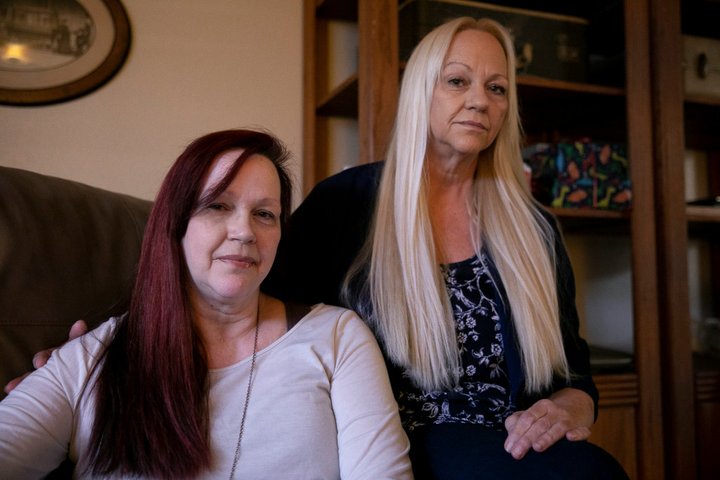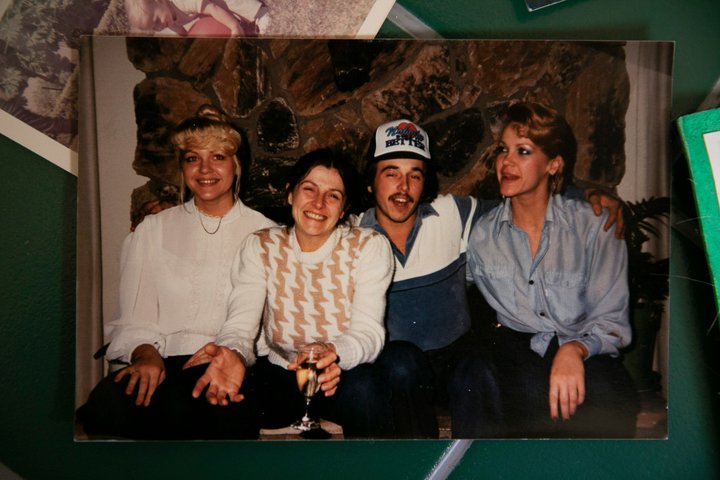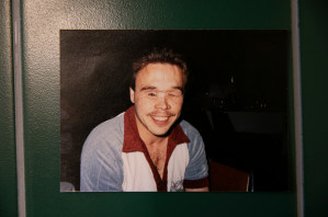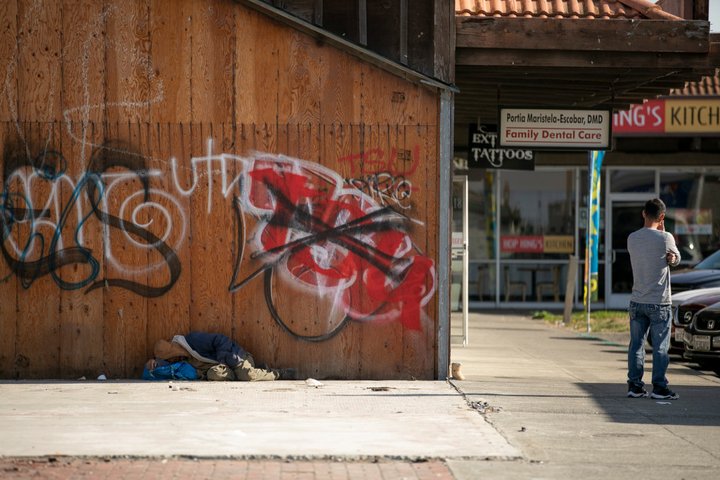
Mark Rippee, who developed schizophrenia after a traumatic brain injury, has been living on the streets for years. Photo by Anne Wernikoff for CalMatters
###
The sightings of James Mark Rippee are all over his sisters’ Facebook.
Someone spotted him sleeping by a furniture store in Vallejo. Someone walked him to a gas station for coffee. Someone prayed for him at Nations Giant Hamburgers.
Rippee, 56, developed schizophrenia after a horrific motorcycle accident more than three decades ago caused a traumatic brain injury and the loss of his eyesight. His delusions range from being an alien, to getting chased by the KKK, to being prevented from collecting his lottery winnings, his sisters say.
In September, he stepped into traffic and was hit by a car, his sisters say, then developed a brain abscess. After weeks in the hospital and a board-and-care, he walked out and his 62-year-old twin sisters – Catherine Hanson and Linda Privatte – weren’t alerted.
Now they couldn’t find him.
Complicating things further: Hanson is bedridden with blood cancer; Privatte is legally blind and cannot drive. They’ve come to depend on a Facebook community, “Mark of Vacaville,” to be their “eyes and ears” on their brother’s situation.
The existence of the 2,000-plus member group, is at once a moving testament to a community’s compassion and an indictment of a system that often leaves the most vulnerable to fend for themselves.
Why do people as sick as James Mark Rippee sleep on our streets? Some blame laws that prioritize civil rights over forced treatment; others point to an under-resourced and uneven mental health system that has failed to provide people like Rippee with long-promised care.
Everyone struggles with the same underlying question: What should be done?
“When we allow people to deteriorate on the streets, or interface with law enforcement that leads to incarceration, what are we doing?” asks Dr. Jonathan Sherin, director of the Los Angeles Department of Mental Health. “We’ve lost our compass.”
State lawmakers are watching a controversial new pilot program to expand forced treatment in San Francisco.
In the meantime, families watch in desperation as loved ones cycle between homelessness, emergency rooms and jail cells. Short courses of medication may lead to the quieting of voices, which, in turn, leads to a release to the streets. Often, as in James Mark Rippee’s case, the family is simultaneously shut out of the conversation and blamed for abandonment.
“Every winter we wonder: Is this going to be the year that he dies?”
— Catherine Hanson
Some of these families are aware of the downsides of involuntary treatment, the miserable side effects of psychiatric medications, the critical shortage of inpatient facilities. They recognize that conservatorship – in which a court-appointed conservator manages another person’s living situation, medical decisions and mental health treatment — is no panacea, and should be a last resort.
James Mark Rippee himself puts it this way: “I don’t need to be in a locked-up facility. It was like I was a hostage.”
In recent years, Rippee’s twin sisters — Hanson, the red-headed warrior, Privatte, the blonde diplomat — have redoubled their decades-long effort to get him help. They worry their own health problems might someday leave no one to fight for him.
“He is the worst-case scenario of anybody being so vulnerable on the streets,” Hanson said. “Every winter we wonder: Is this going to be the year that he dies?”
###
In 1967, a law passed that transformed the treatment of people with mental illness in California.
Until then, it had been fairly easy for a family member to call police to force someone into mental health treatment. Conditions in the state hospitals were frequently abhorrent: Patients wore gunny sacks, sometimes bathed just once a week, and were subjected to lobotomies and electric shock treatments. Too often, people were locked away for life.
Republican Assemblyman Frank Lanterman and Democratic Sens. Nicholas Petris and Alan Short proposed a radical overhaul, which Gov. Ronald Reagan signed into law in 1967.
When the Lanterman-Petris-Short law took effect a few years later, it established strict criteria for involuntary treatment. It imposed specific timeframes for involuntary confinement and limited involuntary holds to those deemed a danger to themselves or others, or gravely disabled. This included the 72-hour hold that police term a 5150.
But within a few decades, Sen. Petris noticed growing numbers of people with serious mental illnesses appearing on the streets and in jails.
In a 1989 oral history, Petris lamented that while the law had promised funding to treat people with mental illness in the community, Gov. Reagan diverted tens of millions allocated back to the state general fund.
“That took the guts right out of this state money for local treatment,” Petris said. “It emptied out the hospitals, but there was no follow-up treatment….In this overemphasis to get away from this tyrannical and oppressive system… of incarcerating people so easily, we went overboard the other way,” he said.
Even when funding was available, “Not In My Back Yard” resistance also made it challenging to locate residential and community treatment facilities. In the half-century since, much of the debate about helping people like Rippee has centered on the Lanterman-Petris-Short law. The state auditor is currently examining it; a report is anticipated this spring.

Mark Rippee’s sisters Catherine “CJ” Hanson, left, and Linda Privatte. Photo by Anne Wernikoff for CalMatters
In recent years, several bills in the Legislature have sought to modify the law, focusing on redefining the term “gravely disabled.” Rippee’s sisters petitioned and testified last year on behalf of a bill that sought to define “gravely disabled” to include not just those who can’t provide for their own food, clothing and shelter, but also those who don’t seek needed medical treatment. It failed, in part because opponents considered it ineffective and dangerously expansive.
More than 5,000 people in the state were on permanent conservatorships, and close to 2,000 were on temporary conservatorships, as of 2016-17, according to data collected by the Department of Health Care Services. The data is incomplete; Scarlett Hughes, executive director of the California State Association of Public Administrators, Public Guardians and Public Conservators calls it “extremely inaccurate.”
Last year lawmakers agreed to create a narrow 5-year pilot program that makes it easier for three counties (San Francisco, Los Angeles and San Diego) to conserve homeless individuals with serious mental illnesses or substance abuse disorders. The program allows courts to conserve individuals who have been placed under a 72-hour psychiatric hold at least eight times in a year. A second law, passed this year, expanded the rules to allow 50 to 100 more people in San Francisco to be placed under conservatorship.
Civil rights advocates have raised serious concerns: In 2018, Susan Mizner, the disability rights program director for the ACLU, described conservatorship as “the biggest deprivation of civil rights aside from the death penalty” and said the law would incentivize police to repeatedly detain homeless individuals.
So far, only San Francisco has adopted it. That reflects another reality: Different counties have different rules. Even without the pilot program, depending on where you live, public defenders, judges, public guardians and others have different interpretations of the law.
“It varies from county to county, it varies within counties,” said Randall Hagar, government relations director for the California Psychiatric Association. “What is ‘gravely disabled’ here may not be considered ‘gravely disabled’ there.”
Because counties must use local funds to pay high placement costs — and because not all counties have the same types of services available — variations are a significant concern.
Disability rights advocates insist that maintaining the standards outlined by Lanterman-Petris-Short is essential to protect people’s civil rights. Most people with serious mental illnesses aren’t refusing help, they say –appropriate help just isn’t available.
Lynn Rivas, associate director of Oakland-based Peers Envisioning & Engaging in Recovery Services, understands that families feel desperate. She knew a woman with paranoid schizophrenia who lived on the streets of Richmond. Mental health workers tried repeatedly, but couldn’t get her to come inside.
Even though “it breaks my heart,” Rivas said, she’s willing to live with that consequence.
“I think involuntary imprisonment is worse,” she said.
Heather, a program coordinator at the organization, has herself experienced involuntary treatment. In the hospital, she said, everything was taken from her and her entire schedule revolved around medication.
“I think it’s just really cold the way they treat you,” she said. “It’s like you have a disease…they treat you like you’re not a human being.”
Once she stabilized, she said, the hospital discharged her back to the streets, without addressing her underlying issues. The experience not only didn’t help her, she said, it made her afraid to seek help.
Some worry that public dismay about the current homelessness crisis will encourage lawmakers to strip people of their rights.
“It’s still political failures that are trying to be masked with solutions that may decrease the visibility of individuals on the street,” said Curtis Child, director of legislation at Disability Rights California. He also compares the situation of people with mental illness to that of people with developmental disabilities. For the latter group, deinstitutionalization was accompanied by the creation of regional centers, he said, “in which everyone gets a plan, everyone gets a worker.”
“With mental illness, we did nothing.”
“It’s like cutting more doors into an empty building … We don’t have the treatments.”
— Dr. Amy Barnhorst
For Child, and many other advocates, the solution is not more conservatorship — it’s creating affordable housing and more robust mental health services.
“The volume of individuals who are entering homelessness on a given day is overwhelming all of our systems,” said Michelle Cabrera, executive director of the County Behavioral Health Directors Association of California,. “We’ve got a serious problem on our hands.”
Dr. Amy Barnhorst, vice chair of community and hospital services for the UC Davis Department of Psychiatry agrees that the focus should be on building out the mental health system, not changing the law.
“It’s like cutting more doors into an empty building,” she said. “There’s not the services there. We don’t have the workforce. We don’t have the treatments. We don’t have the infrastructure. ”
Even if a change in law permitted more people to be conserved, a shortage of placements and “a gross lack of funding” for county programs means there would be nowhere to send many of them, said Hughes, of the California State Association of Public Administrators, Public Guardians and Public Conservators.. Earlier this year, a state budget proposal to increase the amount of funding for public guardians by 35% — or $68 million — failed.
County conservators receive no direct state funding, and in the past five years have received a huge influx in clients diverted from the criminal justice system, Hughes said. Some counties went from five referrals a month to 30 or 40, she said.
“They are drowning,” she said.
Simultaneously, the number of facilities that can take them is shrinking, said Chris Koper, a legislative analyst for the organization. At one point, she said, she and some friends started listing the facilities in that county that had shut down. They stopped when they got to 35, she said: “It was too depressing.”
That leaves many conservatees in a “placement pending” status, stuck in jails or hospitals. In some cases, conservators have resorted to having staff members care for people with mental illness in hotel rooms rather than leave an individual on the streets, she said.
Most state hospital beds are now reserved for people in the criminal justice system. Inmates with mental illness can wait in limbo for months or even years in county jails before a bed opens up. Five years ago, an average of 343 inmates with mental illness were awaiting placement. Last year, the average was 819.
“The easiest legislative fix is to expand conservatorship,” Koper said. “It then will appear that the Legislature is trying to do something. But as is often the case with social problems, the wound is so much deeper than that. And the wound will require a lot of money.”
As San Francisco has assumed new authority to place people under conservatorships, The San Francisco Chronicle found a backlog. In a locked ward at San Francisco General Hospital, individuals who were conserved were waiting four months for placement in Napa State Hospital, and even longer for a residential facility.
A woman who answered the phone at the public guardian’s office in Solano County, where Rippee lives, said she didn’t have time or permission to talk, repeating several times “we’re extremely short-staffed.”
Gerald Huber, the county’s director of Health and Social Services, noted that even if Rippee were to be conserved, there are very few facilities in the state that accept people with traumatic brain injuries — and they are always full with waitlists.
Rippee’s sisters are aware.
“If they tell him, ‘Mark, you’re conserved’ — ” Privatte began.
“ — where are they going to put him?” Hanson concluded. “There’s no place.”
###
The events of June 21st, 1987 are seared in the minds of Rippee’s twin sisters:
Rippee had purchased a Harley Davidson just ten days earlier, but he was already talking about selling it. With his slight frame, the big bike felt unwieldy.
The family had gathered for a Father’s Day barbecue in Vacaville. Rippee, 24, was optimistic about a budding career in construction. He was popular with girls and never went anywhere without his guitar.

A family photo of Mark Rippee with his sister Linda, far left, and Catherine, far right, before his traumatic brain injury
That evening, he took off down a country road toward Hanson’s house. A car swerved into his lane. Trying to avoid it, Rippee steered off the road into a dark field.
A neighbor heard the crash. Officers searched for an hour, following the moans, before discovering a gruesome scene. Rippee had smashed into an antique grain harvester. The impact had ripped his eyes from their sockets, knocked out his teeth, split his head open and strewn brain matter on the ground. Paramedics told the family they were so sure he was dead, they initially didn’t turn on the siren.
His sisters, Privatte and Hanson, rushed to the hospital, where a team of surgeons was attempting to piece their brother’s brain and body back together. Their father was overwhelmed, Hanson said, and asked her to take over medical decision-making.
After Rippee stabilized, a neurosurgeon warned the family it would take a few years for him to recover from the brain injury. Then, at some point, his mental health would decline. The doctor recommended Rippee be transported to a state rehabilitation facility where he might need to spend his entire life, his sisters said.
Instead, Hanson said, their father grabbed the papers giving her legal decision-making over her brother’s care and shredded them. His only son, he insisted, was coming home.
“This is how we lost complete control,” she said.

family photo of Mark Rippee after his motorcycle accident.
Under his mother’s care, Rippee did heal somewhat, his sisters said. He was completely blind, had severe damage to his frontal lobe and was suicidal. But, for a time, he was able to take computer classes.
Then the delusions crept in, his sisters say. He heard voices in the air conditioner. He tried to jump out of a car on a freeway overpass, nearly pulling Privatte with him.
Still, for years Rippee lived with his family. For a while, Privatte housed her brother in a 60-foot trailer adjacent to her house. Neighbor Chris Plowman, at the time a volunteer firefighter, remembers seeing smoke coming from the trailer one morning and hearing Privatte scream “Save my brother! Save my brother!”
Plowman kicked in the door and ran through the trailer, looking for Rippee. He wasn’t inside. The trailer burned to the ground.
Then Rippee threatened to kill his mother with an ax, his sisters say. They say he frightened his niece, Privatte’s daughter, suggesting he might stab her with a fork. Another of Privatte’s daughters started sleeping with a knife under her pillow, in case she needed to defend herself.
Rippee’s family felt it was no longer safe to have him live with them. But, gradually, he ran out of other options. Local motels refused to rent to him, his sister said.
Karen Newton, an office assistant with Solano County, first met Rippee in front of the county building where she worked — he was sleeping on a strip of cardboard. She bought him taquitos and chocolate milk and clean clothes. Newton, whose own son has schizophrenia and is currently in Napa State Hospital, was disturbed by the frequent assaults she saw against Rippee, including a bad beating that left him swollen.
“The things I’ve seen in the last year have been horrifying,” she said.
In the past 15 years, Vacaville police say they have arrested Rippee 25 times, charging him with unlawful camping and public intoxication.
Sgt. Aaron Dahl, who supervises the community response unit for Vacaville Police, says he wants people like Rippee to stay inside, take medications and get help, but “that’s not the reality of how things work.”
“I wish I had a magic wand that could go help everybody,” he said. “And it’s very hard, because there’s not an easy answer for everybody. There’s just not.”
In early 2018, Privatte said her daughter saw members of a Solano County community Facebook site criticizing their family for abandoning Rippee.
“The law has stopped Mark from getting treatment. The law. Not us.”
— Mark Ripee’s sister Linda Privatte
The twins intensified their efforts to help their brother.
“The law has stopped Mark from getting treatment,” Privatte said. “The law. Not us.”
On April 24, 2018, Privatte told the Solano County Board of Supervisors that her brother had attempted suicide more than 20 times, and that other people beat and robbed him regularly.
“It’s not because I want to lock my brother up and be done with him,” she said, crying. “It’s because I want him to be safe.”

Mark Rippee sleeps along a wall at a strip mall in Vallejo — as nights become colder, he prefers to sleep during the day. Photo by Anne Wernikoff for CalMatters
“What can we do to help?” asked Supervisor Skip Thomson. “Because what we’re doing is unacceptable.”
Privatte showed up repeatedly to beg the board for help. This spring, she received an email from Thomson’s office on behalf of the county, explaining that her brother could not be conserved in part because each time he was placed on an involuntary hold, he stabilized to the point that he legally had to be released:
“This is not a situation that we have ignored nor that we condone,” the letter said. “Simply the law requires stringent standards to impose conservatorships–standards that so far we cannot meet.”
Huber, the director of Health and Social Services, said that “many, many, many different agencies” have interacted with Rippee over the years, and the county has made — and continues to make — efforts to provide treatment.
“I’ve struggled with this for the five years I’ve been here,” he said. “The street is not an appropriate place for him to live.”
The county this year implemented Laura’s Law, a 2002 state law which allows for court-ordered outpatient treatment. A few weeks ago, Rippee’s mother applied for it on her son’s behalf. But the program doesn’t serve someone with a traumatic brain injury, Huber said.
###
On September 27th, someone posted a picture of Rippee on the Facebook group. His head looked swollen; his sisters recognized symptoms of a brain abscess.
Privatte convinced her brother to go with her to the hospital, where he had surgery the next morning. After two weeks, the hospital transferred him to a Suisun City board-and-care. In late October, he returned to the streets.
“To leave a blind man outside, you know, I just figured the county could do better than that.”
— Mark Rippee
That same week, dozens of mental health leaders from around the state gathered in Sacramento to talk about the future of Lanterman-Petris-Short. They discussed how counties lack the resources to build out a continuum of care.
Sacramento Mayor Darrell Steinberg asked his colleagues if the debate around involuntary treatment might be reframed to insist that people have both a right — and an obligation — to come indoors. That would mean that, before the state could compel people to come indoors, they would have to have safe, appropriate placements to offer them.
“Our North Star needs to be to end this horrific situation,” he said.
A few weeks later, I found Rippee at a Vallejo strip mall, asleep on a patch of concrete littered with dirty socks and desiccated orange peels. His head rested on a blue IKEA bag, which held a pale green fleece blanket studded with burrs.
After Rippee woke up, he requested a coffee the way he likes it – a lot of sugar, a little coffee. He was friendly and talkative, his facts smoothly interwoven with delusions. He talked about the beauty of classical music. He recalled delivering pies for his parents’ business. Then he toggled to concerns about the KKK chasing him: “I’m trying to stay ahead of those guys,” he said.
Ultimately, Rippee said, he wants home with a shower and someone to care for him. He doesn’t want to be in a locked facility, but he does wish he could live inside.
“At night it gets cold,” he said. “I just sit there and shake.
“To leave a blind man outside, you know, I just figured the county could do better than that,” he continued. “They’re not supposed to leave me outside. The United States of America is nice enough. They’re not supposed to let this happen.”
###
CALmatters.org is a nonprofit, nonpartisan media venture explaining California policies and politics.
CLICK TO MANAGE